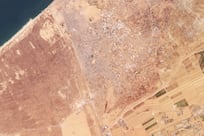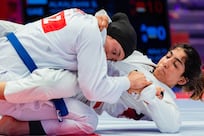Cladding on London’s Grenfell Tower was not tested in fire conditions and did not comply with building-safety guidance, according to an expert’s report released on Monday into last year’s inferno that killed 72 people.
This and other safety failures meant the policy of telling residents to stay in their homes had “effectively failed” within half an hour of the blaze’s outbreak – yet it remained in place for nearly two hours, fire safety engineer Barbara Lane concluded.
She blamed the cladding for causing “multiple internal fires” and large quantities of overwhelming smoke at the 24-storey building. Seventy-two people died in the west London fire, which broke out shortly before 1am on June 14, 2017 and was likely caused by a faulty fridge
“I conclude that the entire system could not adequately resist the spread of fire,” she wrote in her lengthy report commissioned by the independent inquiry into the tragedy.
The cladding was installed during a four-year refurbishment between 2012 and 2016, and has long been suspected of helping to spread the blaze.
“There were multiple catastrophic fire-spread routes created by the construction form and construction detailing,” Ms Lane said.
_______________
Read more:
[ ‘No one should die in such a horrific way,’ say Grenfell families ]
[ Grenfell Tower is a monument to the tragic inequalities of modern Britain ]
[ Grenfell families to miss start of inquiry due to visa delays ]
_______________
“There was therefore an early need for a total evacuation of Grenfell Tower,” she said.
Introducing the expert report, inquiry lawyer Richard Millett said that advice for residents to "stay put" may have cost lives.
He described how 187 occupants of the tower – about 64 per cent – had got out of the building by the time this was changed at 2.47am.
Withdrawing the advice may have been a “mere formality in light of the number of occupants that had escaped safely before that time”.
“On the other hand, it may be that the formal maintenance of that advice until 2.47am made all the difference between life and death,” he said.
“I have found no evidence yet that any member of the design team or the construction ascertained the fire performance of the rainscreen cladding system materials, nor understood how the assembly performed in fire,” Ms Lane wrote.
She also found “no evidence” that local building authorities “were either informed or understood how the assembly would perform in a fire”.
Ms Lane also reported that a “culture of non-compliance” had plagued Grenfell Tower, with basic fire safety measures missing or defective.
Her damning assessment was one of five expert reports released on Monday by the public inquiry detailing how the inferno started, why it spread so quickly and the effectiveness of the fire protection measures in the 24-storey building.
They followed a week of poignant testimony from relatives of those who died.
Grenfell United, the main body for survivors and bereaved families, said ahead of the latest hearing that Monday marked “the beginning of a long road to justice” for those affected by the tragedy.
“It is going to be difficult to see some organisations trying to defend their actions,” it added in a statement.
“But we have trust that as the evidence emerges over the coming months, this inquiry will reveal the truth about how our community was treated before, during and after the fire.”
The inquiry will take evidence in two phases, with the first fact-finding stage focusing on the sequence of events, before the remainder of the issues are addressed later in the year.






